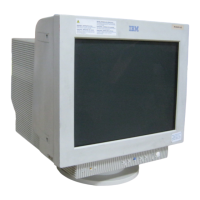How to fix red or blue shadows on white lines on my IBM Monitor?
- CCaroline HernandezSep 9, 2025
If white lines on your IBM Monitor display red or blue shadows at the edges, adjust the convergence settings.

How to fix red or blue shadows on white lines on my IBM Monitor?
If white lines on your IBM Monitor display red or blue shadows at the edges, adjust the convergence settings.
Why does the picture on my IBM P76 Monitor appear to be ghosting?
If the picture on your IBM Monitor appears to be ghosting, eliminate the use of video cable extensions and/or video switch boxes. Excessive cable length or a weak connection can cause this issue.
Why do I hear a hum when I turn on my IBM P76 Monitor?
When the power is turned on, the auto-degauss cycle is activated on your IBM Monitor. During this cycle, a hum may be audible. This is normal and not a malfunction.
What are the two fine horizontal lines visible on my IBM P76?
These wires stabilize the vertically striped aperture grille on your IBM Monitor and are a normal part of the monitor's design.
| Vertical Refresh Rate | 50 - 160 Hz |
|---|---|
| Connectivity | VGA |
| Input Signal | Analog |
| Refresh Rate | 160 Hz |
| Input Connectors | VGA |
Critical safety warnings and handling advice in English, French, German, and Dutch.
Safety warnings and handling advice in Spanish, Italian, Portuguese, and Danish languages.
Safety and handling advice in Norwegian, Swedish, Finnish, and Greek languages.
Turkish safety instructions for electrical hazards and handling of the heavy color monitor.
Identifies IBM as a registered trademark and service mark in the US and other countries.
Guidance on safe installation, cleaning, transport, and tilt-swivel adjustment of the monitor.
Important warnings and guidance on connecting the power cord safely and properly.
Identification and function of front and rear controls, indicators, and connectors.
Details of the AC IN and Video input connectors, including pin assignments.
Step-by-step instructions for connecting the monitor to the computer and power outlet.
Guidance on turning on the monitor and computer and initial control adjustments.
Guide to changing the language of the on-screen display menus.
Instructions for adjusting brightness and contrast using the OSD controls.
Overview of the On-Screen Display system and its main menu options.
How to use the SIZE/CENTER OSD to adjust picture size, centering, and zoom.
Detailed steps for adjusting horizontal/vertical centering and sizing using the OSD.
Using the GEOMETRY OSD to adjust picture rotation, pincushion, and pin balance.
Guide to adjusting keystone and key balance for picture shape and orientation.
How to use the COLOR OSD to change the monitor's color temperature.
Instructions for choosing between preset (9300K/5000K) and variable color settings.
Using the CONVERGENCE OSD to correct red/blue shadows and improve image alignment.
Steps to adjust horizontal and vertical convergence for optimal picture quality.
Guide to selecting the On-Screen Display language from available options.
Instructions for manually degaussing the monitor screen to correct color uniformity.
How to adjust moire cancellation to reduce wavy patterns on the screen.
Guide to changing the position of the on-screen display menus for better viewing.
How to lock monitor controls to protect settings from accidental changes.
Using the HELP OSD to find hints and information for resolving monitor issues.
How to reset specific adjustment settings to factory defaults.
Procedures for resetting all current input signal data or all data for all input signals.
Details on the monitor's power saving modes and compliance with VESA and Energy Star.
Explanation of damper wires characteristic of CRTs and Plug & Play compliance.
List of supported resolution, frequency, and graphics modes.
How to access and view the monitor's model name, serial number, and manufacture year.
Explanation of messages like 'MONITOR IS WORKING' and 'MONITOR IS IN POWER SAVE MODE'.
Troubleshooting steps for no picture, signal cable errors, and power save mode messages.
Resolving issues related to 'OUT OF SCAN RANGE' and scrambled or non-uniform color pictures.
Troubleshooting for screen centering, image curvature, fuzzy pictures, and ghosting.
Resolving color uniformity, moire patterns, flickering, and horizontal line issues.
How to use the self-diagnosis feature to check monitor and computer status.
Detailed specifications including picture tube, resolution, frequency, power, and dimensions.
FCC compliance information for Class B digital devices and declaration of conformity.
Information on using appropriate and safe power cords for the IBM product.
Compliance with Swedish MPRII standards and German notes on ergonomics and color.
Compliance with Mexican NOM standards and Canadian interference regulations.
EU, French, and German statements on Class B digital apparatus compliance and potential image instability.
Spanish and Italian compliance statements regarding interference protection and potential image jitter.
Details of the limited warranty for IBM machines in the US, Canada, and Puerto Rico.
Information on machine production status and how to obtain warranty service.
Details on the scope of the warranty, conditions that may void it, and exclusions.
Information on IBM's liability limits for damages, losses, and consequential damages.
Reference to the enclosed European warranty terms and conditions document.
Explanation of why environmental labelling is important for computers and the environment.
Overview of the TCO'95 scheme requirements covering environment, ergonomics, and safety.
Summary of TCO'99 requirements for flame retardants, lead, cadmium, mercury, and CFCs.
List of part numbers and descriptions for IBM service and authorized dealers.